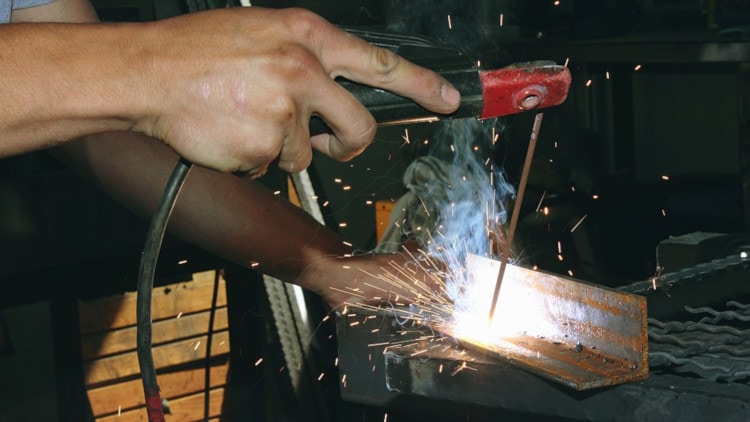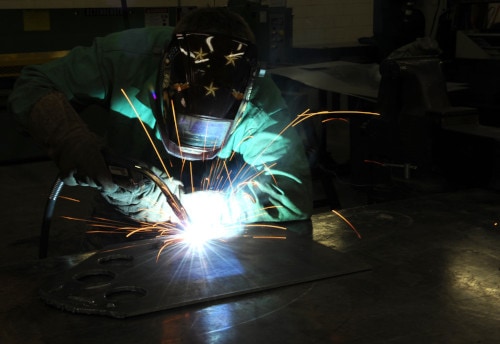How to Weld Cast Iron: A Full Guide (with Pictures)
Last Updated on

It’s a nightmare for any cast-iron machine owner to crack or break a vital cast component. It can mean thousands of dollars in replacement parts or hundreds of dollars for hiring a cast-iron welding specialist. Either option can be chosen, but if you know how to weld and are up for learning a new skill, welding it yourself could solve your problem just as easily.
Cast iron is one of the most challenging materials to weld. A wrong move can ruin your broken part even more, or worse, make your weld look strong when it’s internally weak. Therefore, knowing what you’re doing is more crucial than ever. Following a set of guidelines on how to weld cast iron should ensure that your welds have no cracks and that the internal strength is sufficient to withstand the component’s purpose.
Determining the Type of Cast Iron
The first step of this kind of welding is identifying what type of cast iron it is. There are numerous types, and you won’t want to weld most of them. Here is a list of their weldability:
Gray iron: Weldable with difficulty.
White iron: Almost unweldable.
Ductile iron: Weldable but rare, as it’s an extensive and slow process.
Malleable iron: Not welded, as welding changes the properties of the metal, rendering it useless.
The best way to tell what type of cast iron needs welding is to consult the product manual or contact the manufacturer, if it’s not stated on the material. There’s a slight difference in the look of fresh cracks in the material, but unless you’re experienced in determining this, it pays to find out from the manufacturer.
Gray cast iron is the most common type of cast iron welded, and should be the only cast iron you attempt to fuse unless you’re experienced with casting or welding it. Having someone experienced assist you is another good option.
Choose the Welding Process
Once you’ve determined the material is gray cast iron, the next step is choosing what process you will use to weld it. You can weld cast iron with every welding process, provided you use the right filler material and welding procedure. It’s primarily based upon personal preference, but there are a few factors to consider when welding cast iron.
If you’re welding up a machined surface, the best option would be to TIG weld it. The spatter from MIG or stick welding may unnecessarily damage parts of the machined surface not being welded. TIG welding shouldn’t give you any spatter issues.
Oxy-acetylene welding is another option frequently used to weld cast iron. It’s a good option to minimize the extreme heating and cooling of the electric welding processes, and it’s easier to maintain the temperatures of the components with it.
Brazing isn’t really welding, as it doesn’t fuse the metal as a weld does. However, it’s a good option if you’re having trouble welding it for some reason. Make sure the surfaces the brazing will stick to are cleaned well, as it won’t stick to dirty or rusty iron.
Stick and MIG welding are both desirable options with the right consumables. With the wrong filler metal, it will most likely cause cracking, so be sure you know it’s the right choice to weld cast iron.

Choose the Filler Wire or Electrode
There is only a small range of filler wire and electrodes that will weld cast iron properly. Most of the ones available that haven’t been designed specifically for cast iron cool too quickly and cause stress cracks, or don’t fuse properly with the cast iron.
Electrode and Wire Consumables
Rich nickel content: This is the best type of electrode or wire, as it’s soft and machinable. It doesn’t cool too quickly and looks the same as cast iron. However, these are the most expensive consumables and aren’t suited for welding thick sections.
55% nickel, 45% iron mix: This is a more affordable price and looks the same as cast iron when welded. It produces a machinable weld, although it’s much harder than the 99% nickel welds. It has much lower weld shrinkage than most iron rods, meaning it minimizes cracking.
Iron: This type costs less and produces a different-colored weld than the cast iron. It is much more challenging to use as it has higher shrinkage properties. It’s also not machinable, as it hardens during the welding process, but it can be ground back.
Stainless steel: Cast iron fused with austenite stainless steel doesn’t harden and change properties so much with iron consumables. The stainless steel does expand and contract significantly during the heating and cooling of the welding process, so it’s challenging to use. However, it’s used to weld cast iron and produces a machinable surface.
Brazing bronze: You can oxy-acetylene braze or use the rods with a TIG welder. It’s a good way to provide a strong hold in a crack or between two components needing joining, while not causing cracking and a change of the cast iron properties.
Cleaning and Peening Weld Surfaces
Like most welding, the cleaner the surface is, the better your welds will be. Sometimes the material you’re welding has had a lifetime’s worth of fumes or oil throughout the casting, and this will cause challenges in welding. There are certain things to be aware of when you weld cast iron.
Using welding consumables, like the MG-289 Cast Iron Welding Alloy rods, that are designed for contaminated cast iron is the best way to ensure the weld is sufficient.
Peening is the process of tapping the soft weld as it cools with a ball-peen hammer to prevent cracking. This should be done with caution and only when the weld can deform, but it’s not always necessary, as what primarily causes cracks is the irregular or rapid heating or cooling of the component. Preheating and slowly cooling your project is what’s most important.

Preheat or Cold-Weld?
There are a few different opinions on whether you should weld hot or cold. Everyone agrees that preheating is a good option, but there are a few people suggesting welding with minimal heat is sufficient too.
When deciding on how to weld cast iron, taking one of these approaches is necessary, because unlike most metals, cast iron is brittle and has very minimal ability to deform through bending or expansion and contraction. Heat always has a deforming effect on metal, and if one part of the metal heats or cools faster than another, stress and cracking occur in the cast iron or weld.
Preheating minimizes this effect by bringing the surrounding area of the weld nearer to the welding temperature, making the whole component change uniformly. Cast iron changes characteristics over 1400 degrees Fahrenheit, so it’s crucial not to put excessive heat into the component.
Welding cast iron in a cool manner without preheating and using minimal heat is thought to help this by reducing the overall temperature. This can be beneficial in not producing visible cracks, and it will be a stronger weld than a hot weld without preheating. However, internal stress still occurs, which can show later on in the component’s life, and it produces an overall weaker weld than properly preheating before welding.
Experienced cast iron welders who work on repairing or manufacturing cast iron products regularly always and only preheat. This is the best way to ensure the weld is strong internally, not just visibly crackless.
Cool Slowly
One of the most crucial parts of welding cast iron is the cooling process. You should never quench the weld with anything cold like water or compressed air. Instead, the slower the whole component cools, the better.
Some welds are cooled over many days, but gray cast iron isn’t as critical. Putting the welded piece into sand or a warm oven can help it cool slowly in a more uniform way than having it rest on the bench. Sometimes it is more challenging to achieve this, and you can still produce a quality weld without extending the cooling time excessively. However, the slower it cools, the better a result you’ll have.
See also: How Much Does It Cost to Weld a Diff? Prices & Guide
Final Thoughts: How to Weld Cast Iron
Welding cast iron is no easy task. It requires significantly more preparation and care during the welding and cooling process. However, it’s a metal that’s commonly welded and can produce a strong component that will last just as well as a cast product without welds.
Be sure to follow all the necessary steps on how to weld cast iron, and you will produce the results you need for your next cast iron project. If you take any shortcuts, the weld will most likely crack, or be internally weak and may not last long.
We hope you enjoy successfully welding some cast iron with this guide. Feel free to leave us your comments below in our comment section.
